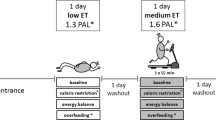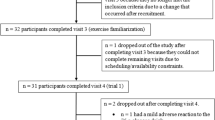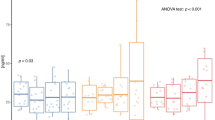Abstract
Background/Objectives:
The purpose of the current study was to determine whether increased physical activity (PA) altered glycemic control while ingesting an energy-balanced high-fructose diet.
Subjects/Methods:
Twenty-two normal-weight men and women (age: 21.2±0.6 years; body mass index: 22.6 ±0.6 kg/m2) participated in a randomized, cross-over design study in which they ingested an additional 75 g of fructose for 14 days while either maintaining low PA (FR+inactive) (<4500 steps/day) or high PA (FR+active) (>12 000 steps/day). Before and following the 2-week loading period, a fructose-rich meal challenge was administered and blood was sampled at baseline and for 6 h after the meal and analyzed for glucagon-like peptide-1 (GLP-1), glucose-dependent insulinotropic peptide (GIP), c-peptide, glucose and insulin concentrations.
Results:
Plasma insulin, glucose, c-peptide, GIP and GLP-1 concentrations significantly increased in response to the test meal on all test visits (P<0.05). C-peptide incremental area under the curve (AUC) decreased by 10 208 ±120 pmol/l × min for 6 h from pre to post Fr+active intervention (P=0.02) leading to a decrease in plasma insulin total AUC (pre: 58 470.2±6261.0 pmol/l; post: 49 444.3±3883.0 pmol/l; P=0.04) resulting in a decrease Δpeak[Insulin] (P=0.009). Following the FR+active intervention, GIP total AUC significantly decreased (P=0.005) yet only males had a lower total GLP-1 AUC after both interventions (P=0.049). There were no sex differences in GIP levels.
Conclusions:
Increased PA attenuates the deleterious effects on glycemic control caused by a high-fructose diet. These changes in glycemic control with PA are associated with decreases in insulin and GIP concentrations.
This is a preview of subscription content, access via your institution
Access options
Subscribe to this journal
Receive 12 print issues and online access
$259.00 per year
only $21.58 per issue
Buy this article
- Purchase on Springer Link
- Instant access to full article PDF
Prices may be subject to local taxes which are calculated during checkout




Similar content being viewed by others
References
Goodyear LJ The exercise pill–ltoo good to be true? N Engl J Med 2008; 359: 1842–1844.
Zderic TW, Hamilton MT Physical inactivity amplifies the sensitivity of skeletal muscle to the lipid-induced downregulation of lipoprotein lipase activity. J Appl Physiol 2006; 100: 249–257.
Dunstan DW, Kingwell BA, Larsen R, Healy GN, Cerin E, Hamilton MT et al. Breaking up prolonged sitting reduces postprandial glucose and insulin responses. Diabetes Care 2012; 35: 976–983.
Jessen N, Goodyear LJ Contraction signaling to glucose transport in skeletal muscle. J Appl Physiol 2005; 99: 330–337.
Kelly KR, Brooks LM, Solomon TP, Kashyap SR, O'Leary VB, Kirwan JP The glucose-dependent insulinotropic polypeptide and glucose-stimulated insulin response to exercise training and diet in obesity. Am J Physiol Endocrinol Metab 2009; 296: E1269–E1274.
Unick JL, Otto AD, Goodpaster BH, Helsel DL, Pellegrini CA, Jakicic JM Acute effect of walking on energy intake in overweight/obese women. Appetite 2010; 55: 413–419.
Morino K, Petersen KF, Shulman GI Molecular mechanisms of insulin resistance in humans and their potential links with mitochondrial dysfunction. Diabetes 2006; 55: S9–S15.
Bleich SN, Wang YC, Wang Y, Gortmaker SL . Increasing consumption of sugar-sweetened beverages among US adults: 1988-1994 to 1999-2004. Am J Clin Nutr 2009; 89: 372–381.
Abdel-Sayed A, Binnert C, Le KA, Bortolotti M, Schneiter P, Tappy L A high-fructose diet impairs basal and stress-mediated lipid metabolism in healthy male subjects. Br J Nutr 2008; 21: 1–7.
Raben A, Vasilaras TH, Moller AC, Astrup A Sucrose compared with artificial sweeteners: different effects on ad libitum food intake and body weight after 10 wk of supplementation in overweight subjects. Am J Clin Nutr 2002; 76: 721–729.
Melanson KJ, Angelopoulos TJ, Nguyen V, Zukley L, Lowndes J, Rippe JM High-fructose corn syrup, energy intake, and appetite regulation. Am J Clin Nutr 2008; 88: 1738S–1744S.
Franklin RM, Baynard T, Weinstock RS, Goulopoulou S, Carhart R Jr, Ploutz-Snyder R et al. Autonomic responses to physiological stressors in women with type 2 diabetes. Clin Auton Res 2008; 18: 66–73.
Stanhope KL, Schwarz JM, Keim NL, Griffen SC, Bremer AA, Graham JL et al. Consuming fructose-sweetened, not glucose-sweetened, beverages increases visceral adiposity and lipids and decreases insulin sensitivity in overweight/obese humans. J Clin Invest 2009; 119: 1322–1334.
Conway J, Ingwersen L, Vinyard B, Moshfegh A Effectiveness of the US Department of Agriculture 5-step multiple-pass method in assessing food intake in obese and nonobese women. Am J Clin Nutr 2003; 77: 1171.
Malerbi DA, Paiva ES, Duarte AL, Wajchenberg BL Metabolic effects of dietary sucrose and fructose in type II diabetic subjects. Diabetes Care 1996; 19: 1249–1256.
Valera Mora ME, Scarfone A, Calvani M, Greco AV, Mingrone G Insulin clearance in obesity. J Am Coll Nutr 2003; 22: 487–493.
Stephens BR, Granados K, Zderic TW, Hamilton MT, Braun B Effects of 1 day of inactivity on insulin action in healthy men and women: interaction with energy intake. Metabolism 2011; 60: 941–949.
McKeown NM, Meigs JB, Liu S, Saltzman E, Wilson PW, Jacques PF Carbohydrate nutrition, insulin resistance, and the prevalence of the metabolic syndrome in the Framingham Offspring Cohort. Diabetes Care 2004; 27: 538–546.
Albaugh VL, Judson JG, She P, Lang CH, Maresca KP, Joyal JL . Olanzapine promotes fat accumulation in male rats by decreasing physical activity, repartitioning energy and increasing adipose tissue lipogenesis while impairing lipolysis. Mol Psychiatry 2011; 16: 569–581.
Leclercq IA, Horsmans Y Nonalcoholic fatty liver disease: the potential role of nutritional management. Curr Opin Clin Nutr Metab Care 2008; 11: 766–773.
Hamilton MT, Healy GN, Dunstan DW, Zderic TW, Owen N Too little exercise and too much sitting: inactivity physiology and the need for new recommendations on sedentary behavior. Curr Cardiovasc Risk Rep 2008; 2: 292.
Rockl KS, Witczak CA, Goodyear LJ Signaling mechanisms in skeletal muscle: acute responses and chronic adaptations to exercise. IUBMB Life 2008; 60: 145–153.
Solomon TP, Haus JM, Kelly KR, Cook MD, Filion J, Rocco M et al. A low-glycemic index diet combined with exercise reduces insulin resistance, postprandial hyperinsulinemia, and glucose-dependent insulinotropic polypeptide responses in obese, prediabetic humans. Am J Clin Nutr 2010; 92: 1359–1368.
O'Connor AM, Pola S, Ward BM, Fillmore D, Buchanan KD, Kirwan JP The gastroenteroinsular response to glucose ingestion during postexercise recovery. Am J Physiol Endocrinol Metab 2006; 290: E1155–E1161.
Mazzaferri EL, Starich GH, St Jeor ST Augmented gastric inhibitory polypeptide and insulin responses to a meal after an increase in carbohydrate (sucrose) intake. J Clin Endocrinol Metab 1984; 58: 640–645.
Adam TC, Lejeune MP, Westerterp-Plantenga MS . Nutrient-stimulated glucagon-like peptide 1 release after body-weight loss and weight maintenance in human subjects. Br J Nutr 2006; 95: 160–167.
Acknowledgements
All authors read and approved the final manuscript. This study was supported by a NIH R21DK084467-01 grant and the Syracuse University School of Education Research and Creative Grant.
Author information
Authors and Affiliations
Corresponding author
Ethics declarations
Competing interests
The authors declare no conflict of interest.
Rights and permissions
About this article
Cite this article
Bidwell, A., Fairchild, T., Wang, L. et al. Effect of increased physical activity on fructose-induced glycemic response in healthy individuals. Eur J Clin Nutr 68, 1048–1054 (2014). https://doi.org/10.1038/ejcn.2014.90
Received:
Revised:
Accepted:
Published:
Issue Date:
DOI: https://doi.org/10.1038/ejcn.2014.90



